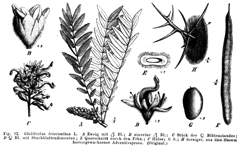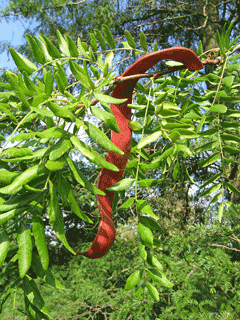 |
|
http://commons.wikimedia.org/wiki/File:Gleditsia_triacanthos_Taub92.png |
 |
| http://www.andrewdunnphoto.com/ |
Translate this page:
Summary
Bloom Color: Yellow. Main Bloom Time: Early spring, Late spring, Mid spring. Form: Oval, Rounded.
Physical Characteristics

 Gleditsia triacanthos is a deciduous Tree growing to 20 m (65ft) by 15 m (49ft) at a medium rate.
Gleditsia triacanthos is a deciduous Tree growing to 20 m (65ft) by 15 m (49ft) at a medium rate.
See above for USDA hardiness. It is hardy to UK zone 3. It is in flower in July, and the seeds ripen from October to November. The species is hermaphrodite (has both male and female organs) and is pollinated by Insects.
Suitable for: light (sandy), medium (loamy) and heavy (clay) soils, prefers well-drained soil and can grow in nutritionally poor soil. Suitable pH: mildly acid, neutral and basic (mildly alkaline) soils and can grow in saline soils.
It cannot grow in the shade. It prefers dry or moist soil and can tolerate drought. It can tolerate atmospheric pollution.
UK Hardiness Map
US Hardiness Map
Synonyms
Plant Habitats
Woodland Garden Canopy;
Edible Uses
Edible Parts: Seed Seedpod
Edible Uses: Coffee Drink Gum Sweetener
Seed - raw or cooked. It can contain up to 30% sugar[160]. Young seeds taste like raw peas[183]. Seeds are not always borne in maritime regions because the tree prefers long hot summers[11]. The oval seeds are about 8mm long[227]. They contain 10.6 - 24.1% protein, 0.8 - 4.3% fat, 84.7% carbohydrate, 21.1% fibre, 4% ash, 280mg calcium and 320mg phosphorus per 100g[218]. The seeds have been roasted and used as a coffee substitute[269]. Seedpods - the pulp is sweet and can be eaten raw or made into sugar[149, 159, 183]. The render young seedpods can be cooked and eaten[183]. The pulp in older pods turns bitter[227]. The seedpods are up to 40cm long and 4cm wide[227]. A sweet, pleasant tasting drink can be made from the seed pods[257]. The seed pulp has been used to make a drink[257].
References More on Edible Uses
Medicinal Uses
Plants For A Future can not take any responsibility for any adverse effects from the use of plants. Always seek advice from a professional before using a plant medicinally.
Anaesthetic Antiseptic Cancer Stomachic
The pods have been made into a tea for the treatment of indigestion, measles, catarrh etc[222, 257]. The juice of the pods is antiseptic[222]. The pods have been seen as a good antidote for children's complaints[257]. The alcoholic extract of the fruits of the honey locust, after elimination of tannin, considerably retarded the growth, up to 63% of Ehrlich mouse carcinoma[269]. However, the cytotoxicity of the extract was quite high and the animals, besides losing weight, showed dystrophic changes in their liver and spleen[260]. The alcoholic extract of the fruit exerted moderate oncostatic activity against sarcoma 180 and Ehrlich carcinoma at the total dose 350 mg/kg/body weight/mouse. Weight loss was considerable[269]. An infusion of the bark has been drunk and used as a wash in the treatment of dyspepsia[257]. It has also been used in the treatment of whooping cough, measles, smallpox etc[257]. The twigs and the leaves contain the alkaloids gleditschine and stenocarpine[4]. Stenocarpine has been used as a local anaesthetic whilst gleditschine causes stupor and loss of reflex activity[4]. Current research is examining the leaves as a potential source of anticancer compounds[222].
References More on Medicinal Uses
The Bookshop: Edible Plant Books
Our Latest books on Perennial Plants For Food Forests and Permaculture Gardens in paperback or digital formats.

Edible Tropical Plants
Food Forest Plants for Hotter Conditions: 250+ Plants For Tropical Food Forests & Permaculture Gardens.
More

Edible Temperate Plants
Plants for Your Food Forest: 500 Plants for Temperate Food Forests & Permaculture Gardens.
More

More Books
PFAF have eight books available in paperback and digital formats. Browse the shop for more information.
Shop Now
Other Uses
Fodder Gum Soil reclamation Tannin Wood
Planted for land reclamation on mining waste[200]. The gum from the seeds has been suggested as an emulsifying substitute for acacia and tragacanth[269]. The heartwood contains 4 - 4.8% tannin[240]. Wood - strong, coarse-grained, elastic, very hard, very durable in contact with the soil, highly shock resistant[46, 61, 82, 149]. It does not shrink much but splits rather easily and does not glue well[227]. It weighs 42lb per cubic foot[227]. Largely used for making fence posts and rails, wheel hubs, farm implements etc and in construction[46, 61, 82, 149].
Special Uses
Carbon Farming Food Forest Scented Plants
References More on Other Uses
Cultivation details
Agroforestry Services: Living fence Fodder: Bank Fodder: Pod Industrial Crop: Biomass Management: Coppice Management: Standard Minor Global Crop Staple Crop: Balanced carb
Landscape Uses:Aggressive surface roots possible, Specimen. Succeeds in most soils, acid or alkaline[160, 200], so long as they are well-drained[202]. Requires a sunny position[11]. Tolerates drought once established[1] and atmospheric pollution[200]. Salt tolerant[200]. The honey locust is speculated to tolerate an annual precipitation of 60 to 150cm, an annual temperature range of 10 to 21°C, and a pH in the range of 6 to 8[269]. Trees are rather tender when young, but they are hardy to about -30°c once they are established[200]. They grow best in southern Britain[11]. The honey locust is often cultivated in warm temperate zones for its edible seeds and seedpods[202], trees start to bear when about 10 years old and produce commercial crops for about 100 years[227]. Wild trees seldom live longer than 120 years[229]. Trees are shy to flower and therefore do not often produce a worthwhile crop in Britain due to our cooler summers[202]. There are some named varieties[183]. The sub-species nana produced lots of viable seed in the hot summer of 1989 at Kew[K], it also had a very good crop in 1994, 1996 and in 1999[K]. The sub-species inermis had a very good crop of pods in the autumn of 1996[K]. 'Ashworth' has pods with a very sweet pulp that has a melon-like flavour[183]. The flowers have a pleasing scent[245]. A very ornamental tree[1], the flowers are very attractive to bees[149, 269]. Trees have a light canopy, they come into leaf late and lose their leaves early[11] making them an excellent canopy tree for a woodland garden. Plants in this genus are notably resistant to honey fungus[200]. Unlike most plants in this family, honey locusts do not fix atmospheric nitrogen[160, 226]. Special Features:North American native, Naturalizing, Fragrant flowers, Inconspicuous flowers or blooms. The plant is heat tolerant in zones 7 through 1. (Plant Hardiness Zones show how well plants withstand cold winter temperatures.
Plant Heat Zones show when plants would start suffering from the heat.
The Plant Heat Zone map is based on the number of "heat days" experienced in a given area where the temperature climbs to over 86 degrees F (30°C).
At this temperature, many plants begin to suffer physiological damage. Heat Zones range from 1 (no heat days) to 12 (210 or more heat days).
For example Heat Zone. 11-1 indicates that the plant is heat tolerant in zones 11 through 1.) For polyculture design as well as the above-ground architecture (form - tree, shrub etc. and size shown above) information on the habit and root pattern is also useful and given here if available. The plant growth habit is a standard with a non-suckering single trunk [1-2]. The root pattern is flat with shallow roots forming a plate near the soil surface [1-2]. The root pattern is a heart root, dividing from the crown into several primary roots going down and out [1-2]. The root pattern is a tap root similar to a carrot going directly down [1-2].
Carbon Farming
-
Agroforestry Services: Living fence
Simply managed rows of shrubs and trees.
-
Fodder: Bank
Fodder banks are plantings of high-quality fodder species. Their goal is to maintain healthy productive animals. They can be utilized all year, but are designed to bridge the forage scarcity of annual dry seasons. Fodder bank plants are usually trees or shrubs, and often legumes. The relatively deep roots of these woody perennials allow them to reach soil nutrients and moisture not available to grasses and herbaceous plants.
-
Fodder: Pod
Fodder plants with pods.
-
Industrial Crop: Biomass
Three broad categories: bamboos, resprouting woody plants, and giant grasses. uses include: protein, materials (paper, building materials, fibers, biochar etc.), chemicals (biobased chemicals), energy - biofuels
-
Management: Coppice
Cut to the ground repeatedly - resprouting vigorously. Non-destructive management systems maintaining the soil organic carbon.
-
Management: Standard
Plants grow to their standard height. Harvest fruit, seeds, or other products. Non-Destructive management systems.
-
Minor Global Crop
These crops are already grown or traded around the world, but on a smaller scale than the global perennial staple and industrial crops, The annual value of a minor global crop is under $1 billion US. Examples include shea, carob, Brazil nuts and fibers such as ramie and sisal.
-
Staple Crop: Balanced carb
(0-15 percent protein, 0-15 percent oil, with at least one over 5 percent). The carbohydrates are from either starch or sugar. Annuals include maize, wheat, rice, and potato. Perennials include chestnuts, carob, perennial fruits, nuts, cereals, pseudocereals, woody pods, and acorns.
References Carbon Farming Information and Carbon Sequestration Information
Temperature Converter
Type a value in the Celsius field to convert the value to Fahrenheit:
Fahrenheit:
The PFAF Bookshop
Plants For A Future have a number of books available in paperback and digital form. Book titles include Edible Plants, Edible Perennials, Edible Trees,Edible Shrubs, Woodland Gardening, and Temperate Food Forest Plants. Our new book is Food Forest Plants For Hotter Conditions (Tropical and Sub-Tropical).
Shop Now
Plant Propagation
Seed - pre-soak for 24 hours in warm water and then sow in spring in a greenhouse[78]. The seed should have swollen up, in which case it can be sown, if it has not swollen then soak it for another 24 hours in warm water. If this does not work then file away some of the seed coat but be careful not to damage the embryo[78]. Further soaking should then cause the seed to swell. One it has swollen, the seed should germinate within 2 - 4 weeks at 20°c. As soon as they are large enough to handle, prick the seedlings out into individual deep pots and plant them out into their permanent positions in the summer. Give the plants some protection from the cold for their first few winters outdoors.
Other Names
If available other names are mentioned here
Native Range
NORTHERN AMERICA: Canada, Ontario, United States, Indiana, Michigan (south), Pennsylvania, Illinois, Iowa, Kansas, Minnesota (southeast), Missouri, Nebraska, Oklahoma, South Dakota (southeast), Wisconsin, Alabama, Arkansas, Florida, Georgia, Kentucky, Louisiana, Maryland (west), Mississippi, North Carolina (west), South Carolina, Tennessee, Virginia (southwest), Texas,
Weed Potential
Right plant wrong place. We are currently updating this section.
Please note that a plant may be invasive in one area but may not in your area so it's worth checking.
Conservation Status
IUCN Red List of Threatened Plants Status :

Growth: S = slow M = medium F = fast. Soil: L = light (sandy) M = medium H = heavy (clay). pH: A = acid N = neutral B = basic (alkaline). Shade: F = full shade S = semi-shade N = no shade. Moisture: D = dry M = Moist We = wet Wa = water.
Now available:
Food Forest Plants for Mediterranean Conditions
350+ Perennial Plants For Mediterranean and Drier Food Forests and Permaculture Gardens.
[Paperback and eBook]
This is the third in Plants For A Future's series of plant guides for food forests tailored to
specific climate zones. Following volumes on temperate and tropical ecosystems, this book focuses
on species suited to Mediterranean conditions—regions with hot, dry summers and cool, wet winters,
often facing the added challenge of climate change.
Read More
Expert comment
Author
L.
Botanical References
1143200
Links / References
For a list of references used on this page please go here
Readers comment